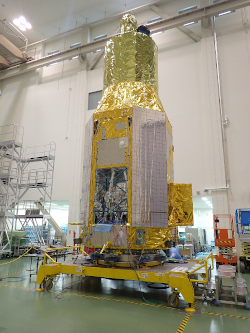 A Final Exam for XRISM
A Final Exam for XRISM
As the saying goes, a picture is worth a thousand words. Astronomers have their own variation on this honored maxim: a spectrum is worth a thousand pictures. A spectrum is the measure of the brightness distribution of the light emitted by an object with wavelength, generally over some limited band of the entire electromagnetic spectrum. It's a rainbow, where we can perceive the indvidual wavelengths of the light being emitted by a glowing object. Analysis of spectra allow astronomers to develop the most complete view of the Universe available, letting us take the temperatures of stars and galaxies, determine what they're made of, and see how they're moving, towards us or away. The image above shows a new tool for high energy astronomers to help perfect our view of the high energy processes in the Universe. This observatory is named XRISM, the X-Ray Imaging and Spectroscopy Mission. XRISM uses a radically new X-ray detector (called Resolve) to determine the wavelength of an individual X-ray photon: when an X-ray photon hits one of XRISM's detectors, it deposits an incredibly tiny amount of heat, and by measuring the resulting temperature increase, Resolve is able to determine the wavelength of the X-ray photon to very high precision. Resolve uses special superconducting material which need to be held near absolute zero. Resolve gives scientists the most detailed view of the X-ray spectrum emitted by high-energy astrophysical objects, especially for extended objects like supernova remnants and clusters of stars and galaxies. The image above shows the XRISM observatory at the Tsukuba Space Center undergoing final testing this past May. The tank holding XRISM's Resolve X-ray Spectrometer can be seen through the open door. XRISM is a joint Japanese-US X-ray astronomy mission, scheduled for launch by Japan on a JAXA HII-A rocket in the late summer this year.
GSFC: JAXA-NASA X-ray Observatory Stands Tall as Testing Begins
| << Previous HEAPOW | High Energy Astrophysics Picture of the Week | Next HEAPOW >> |